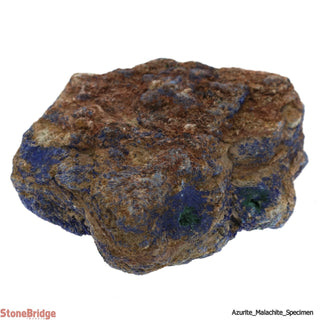Weight range: 60g to 100g Category: Carbonate Mineral Chemical
Formula: Cu2CO3(OH)2 Colour: green, light and dark green bands
Group: Mono-clinic
Formations: crusts, prismatic, tabular, thin splinters, radiating, banded masses, earthy. Luster: vitreous, silky, dull, translucent to opaque.
Cleavage: good in one direction, indiscernible
Brief Description: Malachite is a copper carbonate hydroxide mineral. Malachite is typically found as tiny fibrous crystal crusts or banded polished specimens. Tumble polished or carved specimens often display concentric rings or bobbles, whilst the fibrous forms are like a velvet rich green carpet. Malachite often occurs with Azurite or Chrysocolla. Malachite is used in the jewellery trade and carved into fine specimens of art.
Mythology: Malachite was used as a mineral pigment in green paints from antiquity until about 1800. The pigment is moderately light-fast, very sensitive to acids, and varying in color. The natural form was being replaced by its synthetic form, verditer, among other synthetic greens. It is also used for decorative purposes, such as in the Malachite Room in the Hermitage, which features a huge malachite vase, the Malachite Room in Castillo de Chapultepec in Mexico City, and “The Tazza”, a large malachite vase, one of the largest pieces of malachite in North America and a gift from Tsar Nicholas II, stands as the focal point in the center of the room of Linda Hall Library.
Archaeological evidence indicates that the mineral has been mined and smelted at Timna Valley in Israel for over 3,000 years. Since then, malachite has been used as both an ornamental stone and as a gemstone.
Usage: Malachite is a protection stone, absorbing negative energies and pollutants from the atmosphere and from the body. It guards against radiation of all kinds, clears electromagnetic pollution and heals earth energies. It helps with jet lag, encourages smooth business travel, and protects in travel on congested highways. Malachite is known for being a stone of support for airplane and airline workers as a protection against accidents, miners for protection from unexplained accidents, and for secretaries to stimulate clear thinking. In the workplace Malachite protects against noise, over-bright fluorescent lighting, and harmful rays from technological equipment, negative phone calls and emails. As a stone of travel, Malachite protects and overcomes fears of flying if you empower the crystal before a trip by holding it and envisioning yourself in the wings of the Archangel, Raphael. Metaphysical Properties: It is a diuretic stone and can help cure kidney and gallstones. It fights osteoarthritis, most notably in the spine, and strengthens memory, especially for those with short-term memory lo
Weight range: 60g to 100g Category: Carbonate Mineral Chemical
Formula: Cu2CO3(OH)2 Colour: green, light and dark green bands
Group: Mono-clinic
Formations: crusts, prismatic, tabular, thin splinters, radiating, banded masses, earthy. Luster: vitreous, silky, dull, translucent to opaque.
Cleavage: good in one direction, indiscernible
Brief Description: Malachite is a copper carbonate hydroxide mineral. Malachite is typically found as tiny fibrous crystal crusts or banded polished specimens. Tumble polished or carved specimens often display concentric rings or bobbles, whilst the fibrous forms are like a velvet rich green carpet. Malachite often occurs with Azurite or Chrysocolla. Malachite is used in the jewellery trade and carved into fine specimens of art.
Mythology: Malachite was used as a mineral pigment in green paints from antiquity until about 1800. The pigment is moderately light-fast, very sensitive to acids, and varying in color. The natural form was being replaced by its synthetic form, verditer, among other synthetic greens. It is also used for decorative purposes, such as in the Malachite Room in the Hermitage, which features a huge malachite vase, the Malachite Room in Castillo de Chapultepec in Mexico City, and “The Tazza”, a large malachite vase, one of the largest pieces of malachite in North America and a gift from Tsar Nicholas II, stands as the focal point in the center of the room of Linda Hall Library.
Archaeological evidence indicates that the mineral has been mined and smelted at Timna Valley in Israel for over 3,000 years. Since then, malachite has been used as both an ornamental stone and as a gemstone.
Usage: Malachite is a protection stone, absorbing negative energies and pollutants from the atmosphere and from the body. It guards against radiation of all kinds, clears electromagnetic pollution and heals earth energies. It helps with jet lag, encourages smooth business travel, and protects in travel on congested highways. Malachite is known for being a stone of support for airplane and airline workers as a protection against accidents, miners for protection from unexplained accidents, and for secretaries to stimulate clear thinking. In the workplace Malachite protects against noise, over-bright fluorescent lighting, and harmful rays from technological equipment, negative phone calls and emails. As a stone of travel, Malachite protects and overcomes fears of flying if you empower the crystal before a trip by holding it and envisioning yourself in the wings of the Archangel, Raphael. Metaphysical Properties: It is a diuretic stone and can help cure kidney and gallstones. It fights osteoarthritis, most notably in the spine, and strengthens memory, especially for those with short-term memory lo

JOIN THE CRYSTAL CLUB
Get 20% Off Your Purchase
Get weekly updates on:
Upcoming events & promotions
New arrivals + back in stock
Exclusive online deals






